-
San Francisco International Film Festival 2013

San Francisco International Film Festival 2013 April 25-May 9
ALL FILMS (SFIFF WEBSITE)
FORUMS THREAD
Links to the reviews:
Act of Killing, The (Joshua Oppenheimer 2012)
After Lucia/Después de Lucía (Michel Franco 2012)
Artist and the Model, The (Fernando Truba 2012)
Before Midnight (Richard Linklater 2013)
Chimeras (Mike Matilla 2013)
Cleaner, The (Adrian Saba 2012)
Cold War (Longman Leung, Sunny Luk 2013)
Computer Chess (Andrew Bujalski 2013)
Ernest & Célestine Stéphane Aubier, Vincent Patar 2012)
Eight Deadly Shots (Mikko Niskanen 1972)
Fill the Void (Rana Burshtein 2012)
Frances Ha (Noah Baumbach 2012)
Futuro, Il (Alicia Scherson 2012)
Habi, the Foreigner (María Florencia Álvarez 2012)
Hijacking, A (Tobias Lindholm2012)
In the Fog (Sergei Loznitsa 2012)
Juvenile Offender (Kang Yi-Kwan 2012)
Key of Life (Kenji Uchida 2012)
La Sirga (William Vega 2012)
Last Step, The (Ali Mosaffa 2012)
Leviathan (Lucien Castaing-Taylor, Verena Peravel 2012)
Memories Look at Me (Song Fang 2012)
Museum Hours (Jem Cohen 2012)
Nights with Théodore (Sébastien Betbeder 2012)
Night Across the Street (Raul Ruiz 2012)
Patience Stone, The (Atiq Rahimi 2012)
Pearblossom Highway (Mike Ott 2012)
Penance (Kiyoahi Kurosawa 2012)
Present Tense (Belmin Söylemez 2012)
Rosie (Marcel Gisler 2013)
Sofia's Last Ambulance (Ilian Metev 2012)
Something in the Air (Olivier Assayas 2012)
Stories We Tell (Sarah Polley 2012)
Strange Little Cat, The (Ramon Zürcher 2013)
Tall as the Baobab Tree (Jeremy Teicher 2012)
Thérèse Desqueyroux (Claude Miller 2012)
What Maisie Knew (David Siegel, Scott McGehee 20113)
Youth (Justine Malle 2013)
SFIFF56 Opening Night: What Maisie Knew
April 25; Screening 7:00, Party 9:30 Castro Theatre and Temple Nightclub

The 56th San Francisco International Film Festival opens with a screening of What Maisie Knew.
In this loose adaptation of Henry James's 1897 novel of the same name, Scott McGehee and David Siegel focus on the effects of a marriage's unraveling as viewed through the eyes of a couple's six-year-old daughter. Shuttling between narcissistic parents and bemused but compassionate parental stand-ins, young Maisie comes face to face with the mercurial world of grown-ups who are anything but. With Julianne Moore, Alexander Skarsgård, Onata Aprile, Steve Coogan. Directors Scott McGehee and David Siegel and Actor Onata Aprile Expected!
SFIFF56 Centerpiece: Inequality For All
May 4; Screening 6:30, Party 8:30 Sundance Kabuki Cinemas and Roe
Director Jacob Kornbluth and Subject Robert Reich Expected!

At the center of the Festival is an extraordinary event featuring an impassioned new film by a celebrated director followed by a chic lounge party at one of San Francisco's hottest nightspots, Roe. Be part of one of the Festival's most anticipated events. For more film and party details, visit sffs.org.
In this Inconvenient Truth for the economy, the Sundance Special Jury Award-winning Inequality For All introduces former Secretary of Labor (and current UC Berkeley professor) Robert Reich as an inspirational and humorous guide in exploring the causes and consequences of the widening income gap in America and asks what is means for the future of our economy and nation. Passionate and insightful, Reich connects the dots for viewers by providing a comprehensive and significantly deeper understanding of what's at stake if we don't act.
Closing Night film: Richard Linklater's BEFORE MIDNIGHT
May 9; Screening, 7:00, Party 9:00 Castro Theatre and Ruby Skye *
Director Richard Linklater Expected!

They're still the same romantic, articulate and gorgeous couple that met on a train in Linklater's Before Sunrise (1995), but now, nearly 20 years on, Jesse and Céline (Ethan Hawke and Julie Delpy) are approaching middle age and facing questions of commitment, family and, as ever, the staying power of love. Before Midnight, with a funny and touching screenplay cowritten by Linklater and his two lead actors, is that rare sequel (rarer still: a sequel to a sequel) that not only delivers the charm and energy of its antecedents but adds layers of poignancy, standing firmly on its own as a mature observation of love's pleasures and discontents. With Julie Delpy, Ethan Hawke, Seamus Davey-Fitzpatrick, Jennifer Prior, Charlotte Prior.
Last edited by Chris Knipp; 01-03-2015 at 11:09 PM.
-
Fernando Trueba: THE ARTIST AND THE MODEL (2012)
FERNANDO TRUEBA: THE ARTIST AND THE MODEL (2012)
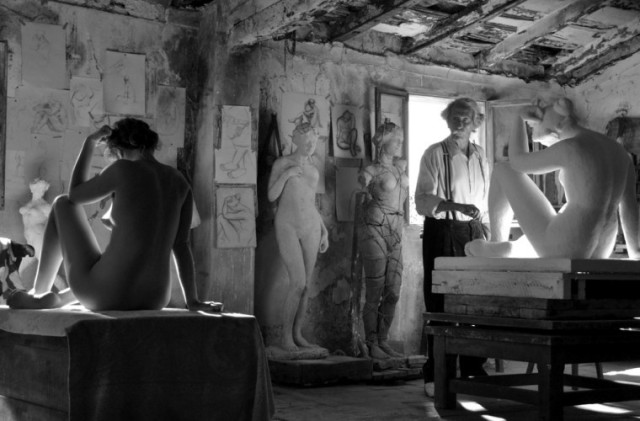
AIDA FOCH AND JEAN ROCHFORT IN THE ARTIST AND THE MODEL
Which is the model?
In black and white, with a faultless evocation of the Forties, Spanish director Fernando Truba's The Artist and the Model depicts an aging sculptor called Marc Cros (he has known Cézanne and Matisse) who briefly works with a young woman, a refuge from Spain, just taken over by Franco, Mercè (Aida Folch). It's the summer of 1943, in occupied France, not far from the Spanish border. Jean Rochefort is the sculptor, and as his once beautiful wife Léa we get none other than Claudia Cardinale. The screenplay was written by Jean-Claude Carriére, who wrote all of Luís Buñuel's French language scripts. These credentials are enough to recommend this quiet, inconsequential but immaculately composed film to festival and mature art house audiences.
American viewers may remember Jean Rochefort playing opposite Johnny Hallyday in Patrice Leconte's 2002 L'homme du train/Man on the Train. He even had a role in the high-speed French thriller Tell No One. But I always think of the story told in the documentary Lost in La Mancha (also 2002) of how Terry Gilliam's film version of Don Quixote was sabotaged when Jean Rochefort hurt his back and could not play the lead. Tall, aristocratic, fine-boned, but with an erratic slightly sleepy look in his eyes, the perennial Rochefort, who is now 82 and has been in movies since the Fifties, would have been a perfect Don Quixote -- for looks, anyway. He seems a bit distant as a actor, and usually appears on the periphery of films even when he's at the center of them. That's why it's moving to see him as the main character in a classic, almost mythical story. Girl comes, artist makes sculpture of girl, girl goes away, artist fades. A famous artist in retreat, Marc Cros is a tired and disillusioned man, not a stretch for Rochefort with his weary, far-away look.
What distinguishes this film apart from its Mediterranean light and quiet rhythms (World War II is winding down, but seems far away), is its sweetness. The young woman is not pouty like the one who poses in the pretty new film Renoir (R-V 2013). She seems ready to make love to the old artist, and does kiss and caress and hug him. And he tells her his wife was the most beautiful model who ever posed for him. Mercè and Léa caress each others faces in parting and tell each other how beautiful they are. The sculptor struggles to get started (what else?) but then turns out a mid-sized plaster cast of a woman with elbow on knee that's almost worthy of Maillol. In a major monologue, he tells Mercè there are two and only two proofs of the existence of God: the body of woman, and olive oil -- a life lesson from the 81-year-old Jean-Clause Carrière, no doubt. One of the true stars of the film is the artist's cluttered studio full of maquettes, plaster sculptures, drawings, and soft light. Props to cameraman Daniel Vilar for his fine use of black and white, which heightens the focus on the charcoal drawings and plaster models of the briefly reborn old sculptor. Aida Folch hasn't much to do but pose nude, but she has an earthiness that rings true in this otherwise awfully slow-moving and self-conscious effort.
Compare this little film with Jacque Rivette's almost four-hour La belle noiseuse (1991) starring Michel Piccoli, and you will see how much more complex a treatment of the artist-model relationship can be. And compare the careers of Piccoli and Rochefort. Piccoli is 87 now, but he is still starring in major films. Rocefort seems, in contrast, almost like a model himself more than an artist. With his tall, thin stature, his handsome "triste figura" and fine mane of hair, he always looks good in every shot, but does not add much more to the shot than his looks. However, the sadness in his face plays well into the final moments of this little film.
El artista y la modelo (the original title Spanish even though 95% of the dialogue is in French: Cardinale speaks French fluently, having been born in 1938 in Tunis) debuted at San Sebastien in September 2012 and was released in France 13 March 2013. It was not too badly received (Allociné press rating 3.4), but critics did note the sad truth that it is stiff, boring, clichéd, and yes, a "pale copy of La belle noiseuse." Screened for this review as part of the SFIFF, April 2013.
Opened in NYC August 2, 2013. Metacritic rating 49.
Last edited by Chris Knipp; 01-03-2015 at 10:24 PM.
-
Alicia Scherson: IL FUTURO (2012)
ALICIA SCHERSON: IL FUTURO (2012)
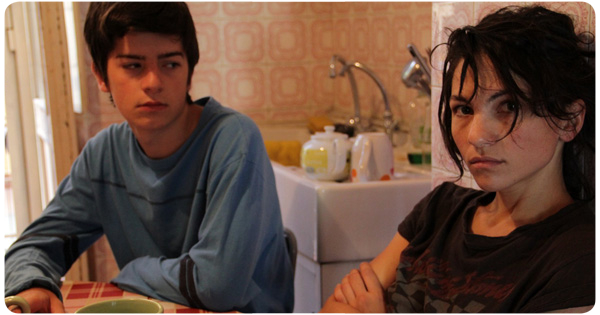
LUIGI CIARDO AND MANUELA MARTELLI IN IL FUTURO
Orphans in Rome
For her third feature Chilean writer-director Alicia Scherson -- whose Santiago-set debut, Play, (SFIFF 2006) I loved -- has adapted a final hitherto untranslated novella, Una novelita lumpen, by the noted Chilean writer Roberto Bolaño (1953-2003). (Bolaño's National Book Critics Circle Award-winning Pynchon-like 2666 is his best known work in the US.) Viewing Il Futuro at Sundance, Variety's Alissa Simon called it a "moody head scratcher," and the story's trajectory indeed makes it wind up feeling atmospheric but curiously inconsequential; one wants to say "So what?" In a nutshell, Bianca (Manuela Martelli) and her younger brother Tomaso (Luigi Ciardo) become orphans in Rome when their parents are killed in a car accident, and falling heir to their father's pension they're allowed by home services, on approval, to live on by themselves in their parents' nice suburban apartment. They both see a strange bright light, made visible to them, according to Tomaso, by "paranormal" energy released by the accident -- one of several novelistic ideas fed to us too fast to make sense of. Hanging out in a gym now instead of gong to school, Tomaso brings two dubious young body builders/"personal trainers" to the house and they not only move in, but sleep with Bianca, and then persuade her to begin sleeping with a decrepit and now blind ex-Mr. Universe and former star of Italian Hercules or Maciste movies (Rutger Hauer), to find a stash of money they think the paranoid, reclusive "Maciste" has stored in a strong box at his big dark house.
Il Futuro begins with handsome film noir or Sixties Italian B-picture opening credits, and the tech aspects are all fine. The film's betrayal of conventional expectations fits Scherson's genius as exhibited in Play, and its lack of point seems intentional: it's all meant to be seen as a youthful episode: what counts is not this but the future, "il futuro." At the end Bianca and Tomaso have said goodbye to Maciste and the sleazy gym rats and are ready to move on, though they still have a feeling of apprehension about something ominous in the air. If the Rome of Il Futuro, which is in Italian and English and appears to follow Bolaño's novel rather faithfully, hasn't the intimate and personal feel of the filmmaker's Santiago in Play, it again has vivid, clearly realized scenes (or memorably murky ones in the house of the blind old actor) and a sense of place, and the people also are distinctive and present. But while Scherson's new film comes closer to conventional narrative then her two earlier ones, it's only close enough to leave one frustrated.
Play took place in bright sunlight. Il Futuro is dominated by the oppressive "afa" of a Roman summer, and subtly ominous throbbing music (by Caroline Chaspoul and Eduardo Henriquez) dominates the scenes, especially the ones in the dim interiors of Maciste's house, where the photography mimics his blindness by making it hard for the viewer to discern spaces clearly. There is a certain humor in the scenes at home with the sub-mental harmlessly thuggish body builders Libio (Nicolas Vaporidis) and Boloñes (Alessandro Giallocosta), "blood brothers" who are very domestic, straighten up, do the dishes, and serve proper cooked meals like lasagna or spaghetti and meatballs, but otherwise live like slobs. While Bianca is always going out for her dark sessions with Maciste (who thinks he is rotting inside and his sperm is turning black) or to work at the hairdresser's where she's taken a servile job, Tomaso watches porn pirated off the cable TV system, hoping to train for when he loses his virginity. There is constant snacking, making of sandwiches by Maciste, and everyone is always popping open canned soft drinks.
Tomaso's and Bianca's giving up going to school and getting involved in these inconsequential digressions, parallel to the "fugures" in Play, seems to be a sign that the sudden loss of their parents has left them rudderless and rebellious. For a while Tomaso follows Libio and Boloñes around like a puppy, but he doesn't seem in their thrall. Bianca, whose voiceovers punctuate the film, thinks for a while she's in love with Maciste (Rutger Hauer, speaking only English, seeming alternately sad, menacing, or strange). But she decides the search for the strong box is stupid and she's not interested in Maciste any more either, and she commands the body builders to move out while she and Tomaso go for a walk in the Roman hills and eat ice cream cones. And that's the end of it. Maybe you would get it better if you'd read Bolaño's novella. Il Futuro isn't satisfying, but I'll still think Scherson is a smart, distinctive filmmaker.
Il Futuro debuted at Sundance, and a week later at Rotterdam. Theatrical releases are set for Italy 6 June and Germany 12 September 2013. It was screened for this review as part of the SFIFF (showing May 7-8-9, 2013 ).
Last edited by Chris Knipp; 01-03-2015 at 10:25 PM.
-
María Florencia Álvarez: HABI, THE FOREIGNER (2012)
MARÍA FLORENCIA ÁLVAREZ: HABI, THE FOREIGNER
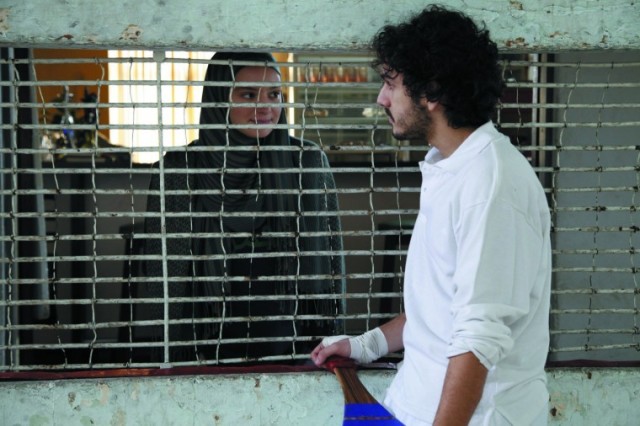
MARTINA JUNCADELLA AND MARTIN SLIPAK IN HABI, THE FOREIGNER
Running away and joining a mosque in Buenos Aires
In Argentinian director Florencia Alvarez's first feature, Analia (Martina Juncadella), a 20-year-old from the provinces whose family runs a hairdressing salon, comes to Buenos Aires to deliver a package, and, running into a funeral in the Muslim community, feels welcomed. She's even given several of the possessions of the deceased. This somehow contributes to a decision to change identities. She phones excuses to her mother and stays in town, checking into a cheap, raucous residential hotel. She starts to "pass" as an orphaned refugee from Lebanon making up the name Habiba Rifat, Habi for short. She goes to an Arabic class at the mosque and the ever-friendly women put Muslim headdress on her. The consistently excellent Juncadella plays her character as shy and delicate, but also supple and protean, adept at deception. She fools us too, so we aren't surprised when she gets a delivery job at the Lebanese grocery -- some of these details are vague. This in turn leads her to meet Hassan (Martin Slipak), a handsome young employee who was brought from Lebanon at the age of five and feels estranged from his origins in spite of being able to read, write, and speak Arabic. Hassan is immediately drawn to Analia and she to him, and this leads to a date, which "Habi" botches. And then the deception begins to fall apart. In frustration with the date gone wrong, Analita gives in to her rowdy house-mate Margerita's invitation to come partying and the headdress is off, the hair flows and so does the beer, and the modest, pious "Habi" is drinking and dancing.
Reviewing the film at its Berlin debut for Hollywood Reporter Stephen Dalton called it a "puzzling portrait of cultural tourism taken to extremes," alluding to how the concept of the film is more intriguing than convincing, questions posed but unanswered, the coincidences and accidents that make the Muslims believe in "Habi" too easy.. There are pluses, however, beginning with the compelling performance of Martina Juncadella, whose mobile face you can't take your eyes off of. Florencia Álvarez maintains delicacy and texture in the unfolding of the story, which stays very close to its protagonist. Details about Islam are never botched. A sense of authenticity is greatly helped by participation of what appears to be an authentic Venezuelan imam in an acting role, a Spanish speaker who can intone the Qur'an beautifully. The mesmerizing sound of Qur'anic recitation is one of the things that first attract Analia to the community, which is depicted as peaceful and welcoming. Florencia Álvarez has said that she conceived the film several years before 9/11, before Muslims were associated so much with terrorism or paranoia. There are some good random touches, such as the funny young girl at the hotel desk (noted by Dalton) who insists in speaking to everybody in English, and the frightening fight between Margarita and a boyfriend that makes Analia cringe in her little room. This "hotel" seethes with convincing seediness just through the sound track.
Motivation for Analia's risky deception isn't provided. It also remains hard to see how she could deceive people, including the sweet religious student who befriends her, Jazmín (Lucía Alfonsín), simply by claiming to be an orphan. In adopting a fake identity, language and religion are serious hurdles. Analia's sudden rejection of the pose is also unmotivated, and the manner of it ill fits with her previous reserve. Of course anything is possible, but this film doesn't make it seem quite as possible as it should. To say as Giovanni Marchini Camia of Film Comment does that this film is "a variant of Antonioni’s thesis from The Passenger within a much more modest scope," is almost as ridiculous as saying it's a variant of the Bourne series, and his claim that this is an "insightful" consideration of "disorientation" at a moment of developmental confusion depends on ignoring how much the film focuses on superficial role-playing. It's nice, though, as Camia says, that Islam is shown as welcoming rather than exotic or dangerous.
Habi, la extranjera was co-produced by Walter Salles. As mentioned it debuted at the Berlinale, 12 February 2013, and it has shown at several other festivals. It was screened for this review in connection with the San Francisco International Film Festival, 25 April-May 9, 2013.
Last edited by Chris Knipp; 01-03-2015 at 10:26 PM.
-
Jem Cohen: MUSEUM HOURS (2012)
JEM COHEN: MUSEUM HOURS (2012)
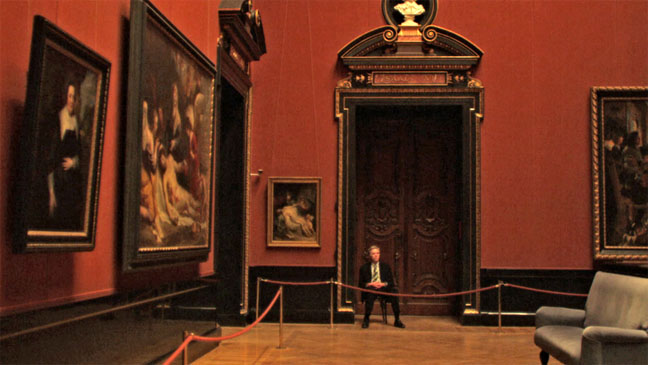
INTERIOR OF THE KUNSTHISTORISCHES MUSEUM OF VIENNA WITH BOBBY SOMMER FROM MUSEUM HOURS
Art and life in Vienna
Tall, grey haired, amiable and pensive, Vienna-born Booby Sommer could be a university lecturer. In his youth he was a promoter and manager for punk bands. In Jem Cohen's semi-documentary exploration of Vienna's Kunsthistorisches Museum, he's one of the guards, though he doesn't seem to be guarding anything. Rather he drinks in the work and ponders it and chats with visitors, sometimes at length, wandering the great rooms of the great museum, with their rich red, green, and brown walls and seemingly endless supply of old masters. Particularly so with a Canadian woman, Janet (cult singer and sometime actor Mary Margaret O’Hara), who's come to Austria to provide company for a relative long resident here who's in a hospital, comatose. The guard begins to accompany her sometimes, also on walks or visits to taverns. Cohen meanwhile provides a rich supply of supplementary images. It's winter. What makes Museum Hours special, because there's not a great deal happening otherwise, is the way it teaches us to see, refreshing our ability to focus on great paintings and helping us take the same eye out of doors. The difference between inside and out is enhanced by the film's two different formats. The museum views are shot in sharp, accurately colored HD. The rest were shot on Super 16, keeping softness and delicate color in the digital transfer, so they have a delicious and original faintly brush-stroked texture. And Cohen never shows you anything obvious. But besides the ideally calm, civilized, European personality of Bobby Sommer what I cheafly take away from Museum Hours are those soft, nubbly, pastel-y winter Vienna citiscapes.
A scene of Janet singing to her comatose relative in semi darkness, with fading sunlight, is memorable and special. A handsome middle-aged woman giving a tour of the Breugels (Ela Piplits) seems to tell the usual art historical message of the panoply of peasant life and the off-center angles on great events, but when she gets to Auden's poem you realize this is no ordinary lecture. There is an extra touch of passion and wisdom.
It seems for no special reason that we see boys skateboarding out of doors. But then we cut to adolescents sitting on a bench in the museum and the guard talks about how they flaunt their boredom, but ogle the sexy canvases. He also recounts extensive discussions he had with a young man who came for a while talking of "Late Capitalism" and conspicuous consumption in the teutonic still lives, saying they were the same as if an artist drew Rolexes today.
The young man suggested the museum is irrelevant. Maybe so if the triumphs of western art mean nothing to you, but the young man kept coming back. The Kunsthistorisches Museum is a treasure trove of Breugel, Rembrandt, and Vermeer. There are also notable works by Rubens, Arcimboldo ("Summer" and "Winter"; "but 'Spring' is in Paris," the guard dryly observes), Van Eyk, Dürer, Tinturetto, and Caravaggio. But this film is not a tour, and only focuses at length on the most heavily emphasized figure, Pieter Brueghel the Elder. It's also pointed out, apropos of the Rolexes gibe, that museums are a relatively new thing and make the status symbols of the rich available to everyone, though it would be nice if both museums and movies were free.
Janet's understated observations seem idiosyncratic and original and, most of the time, unscripted.
A museum is a splendid place for unnoticed people-watching. The guard notes this but the film doesn't indulge too deeply in it because to do so would be to become too aimless and lose the sense of keen, intelligent observation that Cohen shows and awakens.
Cohen, who has a philosophy background, has been a prolific and idiosyncratic documentary fimmaker, working entirely outside the commercial mainstream for thirty years on a wild variety of topics. These include a 1987 History of New York (his place of origin and home base) full of street scenes, Real Birds (from last year) a portrait of Brooklyn through people, objects and birds. Among the SFIFF 56 POV Award recipient’s other honors are a John Simon Guggenheim Fellowship and an Independent Spirit Award. In 2005, the Herb Alpert Foundation awarded Cohen with its Alpert Award in the Arts, stating that he “mines the forces, wonders, damages and poetry of everyday life.” Museum Hours is one of his most elaborate, dialogue-scripted works. Indeed it could have been a bit less elaborate. As I am not alone in observing (Hollywood Reporter's Stephen Dalton says so), it would play better if lightened by 15 or 20 minutes.
Museum Hours, 107 mins., debuted at Locarno August 2012 and has shown at other festivals. It will be 28 April 2013 shown along with Cohen's receipt of the POV ("Persistence of Vision") award at the San Francisco International Film Festival and was screened as part of that festival for this review.
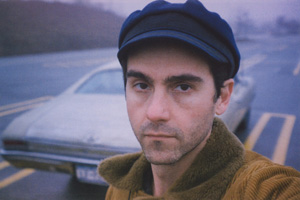
JEM COHEN, RECIPIENT OF SFIFF 2013 POV AWARD
Last edited by Chris Knipp; 08-14-2015 at 07:57 AM.
-
Sébastien Betbeder: NIGHTS WITH THEODORE (2012)
SÉBASTIEN BETBEDER: NIGHTS WITH THEODORE (2012)
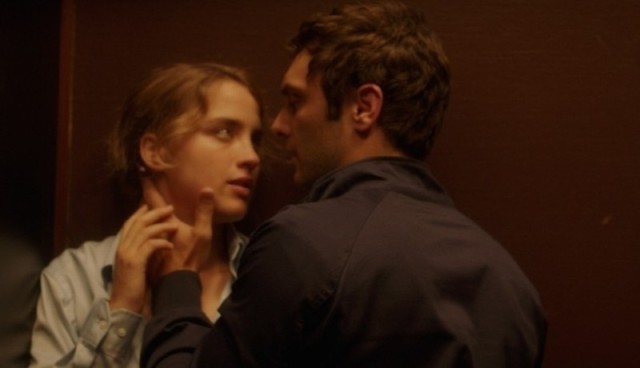
AGATHE BONITZER AND PIO MARMAÏ IN NIGHTS WITH THÉODORE
A romantic revery in a minor key at the Buttes-Chaumont
Sébastien Betbeder's little film is a mixture of things, mainly, perhaps as the Slant review of it at Film Comment Selects says, environmental psychology and romantic idealism; a romantic love affair anyway, that gets sidetracked by an nocturnal obsession with a Paris park. The film begins with a history review of the Paris Parc des Buttes-Chaumont with a soft, enticing young female voiceover (by Nathalie Boutefeu ) that runs back to surprisingly vivid moving images of the park in the nineteenth century. The young lady describes, and we see, open spaces, a waterfall, an artificial lake, and a temple, and long-ago crowds of children in dark clothes and men in bowler hats. The Buttes-Chaumont stands high up in the northeastern corner of Paris in the 19th arrondissement, and when the story takes place on warm summer days it's full of people in the daytime, empty at night.
With this prologue the film jumps to a party at a Parisian apartment where Théodore (Pio Marmaï) meets Anna (Agathe Bonitzer), they dance, and there's good chemistry. They wander outside to the park and Théodore persuades Anna to climb over the fence to wander inside it. They make love, and decide to spend the night lying entwined under a wide leafy tree. And then next morning by the Métro they exchange coordinates and agree to meet and spend the next night there too. In the nights that follow they explore more of the park, and the nocturnal meetings there become a compulsion on both parts, perhaps a physical and psychological necessity for Théodore. In the daytime she's an art history major and he's an at-home proofreader, but they begin just sleeping in the daytime. And he suffers from severe asthma, though in the park at night, he's okay.
They find an abandoned pavilion and spend their nights there, though there are meditators and a nutty vagabond writer (Fabrice Adde) also in the park at night. And then things start to go wrong, and the film itself starts to come apart, unable to sustain its various strands. Still it has a certain very French and Parisian charm, seducing one at the outset and then becoming very subtly and strangely sad and upsetting, all the while intersperced with an indie-rock soundtrack that includes Antlers, Beach House, and That Summer, and nice twilight and dawn images of this quite lovely park, which few foreign tourists are likely to ever see.
Anna's older sister Suzanne (Sarah Le Picard) learns of this obsession and urges her to abandon it, and she persuades Théodore to go to a family beach house to take a break, but he has an asthma attack after three days and insists he must get back to the park. When they return to the Buttes-Chaumont Théodore becomes more possessive, there is a clash with the kooky writer that turns violent and Anna flees, her occasional voiceover ending with the declaration that she never saw Théodore or returned to the park again.
Early on there's a short interview with a (real) psychiatrist indeed specialized in environmental psychology (Dr. Emmanuel Siety) who describes how this park can have a positive power as a place. He learned of a man who lived near the Parc des Buttes-Chaumont and walked through it every day on the way to work. When his work transferred him to the city of Nantes he fell into a depression and became so incapacitated he was confined to a wheelchair. The psychologist recommended his resettling back in his old neighborhood and, monitoring his daily returns to the park, says they gradually brought him back to health. There is also the suggestion of something occult and hidden in a cave the group of meditators think lies under the park containing an enormous life-giving energy. But it's also true that the park above all belongs to the public, and to the many activities that take place there in the daytime, especially during the summertime when this story unfolds.
Nights with Théodore is initially sexy and romantic and French; atmospheric and instructive; finally a little strange and creepy. It's an interesting little film, and at least one reviewer called it "Rohmeresque," but it may try to stuff too much into one package and thus undercuts its main theme of the summer romance that, however conventional it may seem, is the essential thread that holds things together. And so a film that begins well loses its charm, though Betbeder's intent is clearly to focus on mysterious, haunting and spooky aspects of the place, at least as much as on the couple.
Les nuits avec Théodore, only 67 mins., a TV movie, whose original title IMDb lists as Je suis une ville endormie, was shown at the Turin Festival, which gives detailed information. It is roughly his fourth short feature; his longest is 81 minutes. It opened in Paris 13 March, receiving fair reviews (the Allociné press rating is 3.1 based on 11 reviews). It played in Film Comment Selects at Lincoln Center, NYC, 22 February 2013. It was screened for this review in connection with the San Francisco International Film Festival, 25 April-May 9, where it received the FIPRESCI Award.
Last edited by Chris Knipp; 02-24-2017 at 11:08 PM.
 Posting Permissions
Posting Permissions
- You may not post new threads
- You may not post replies
- You may not post attachments
- You may not edit your posts
-
Forum Rules








 Reply With Quote
Reply With Quote






Bookmarks